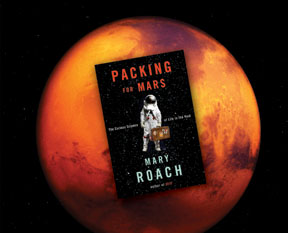| << Back |
In Review: Packing for Mars: The Curious Science of Life in the Void
By Mary Roach
As Reviewed by Macy Walsh
Mary Roach has an uncanny penchant for tracking down the answers to the questions you never knew you had about the human body. In the past, her sideways curiosity has led her to write about the fate of cadavers (Stiff) and the science of sex (Bonk). Now, with Packing for Mars she investigates what happens to our normally earthbound selves when we’re blasted off into zero gravity. It is an utterly fascinating account which is made all the more entertaining by the author’s ever-amused tone.
Astronauts sweat. They also eat, pass gas, defecate, get on each other’s nerves and, at least sometimes, get motion sickness. Their bodies react to weightlessness in all sorts of unpleasant ways, from losing bone mass and muscle density to having fluids pool inside of their heads. In short, despite their larger-than-life auras, astronauts are still human, thus spectacularly unsuited for traveling in zero gravity. Yet, we still insist on sending them up there, and even more, we expect them to survive. It is these undeniable human notions that led Roach to write Packing for Mars, an assignment that exercised her laudable human curiosities. Who better than Mary Roach to tell us how NASA and the world’s other space agencies prepare their astro-, cosmo-, and whatever-nauts to stay alive in a scenario in which even changing their underwear proves to be nearly impossible.
Roach takes enormous delight in what she does. This is not surprising, for her research leads her to chat about things like “fecal popcorn,” in-helmet upchucking, and the fact that only half the human population is capable of igniting their own farts. Who wouldn’t have fun asking the straight-laced scientists at NASA to explain how one gets a “good seal” on a space toilet? Clearly, this is not your typical sober examination of the mission to conquer space. While Roach is interested in heroics and technological awesomeness, she is even more compelled by what those things do to humble our limited human bodies. With Packing For Mars, she hones in on the most bizarre and surprising details in the history of space travel.
Certainly Roach shows how space programs reflect the character of their respective nations: on the Russian Mir space station, cosmonauts are alleged to settle disputes with a friendly fistfight; Japanese astronauts in training are required to construct one thousand origami cranes (the results of which are examined for their psychological revelations); and American astronaut John Young displayed his fun-loving patriotism by smuggling a corned beef sandwich onto Gemini III.
Similarly, the cultural differences extend to animals. The remains of Belka and Strelka, the first dogs to return alive from space, have been stuffed and are now on display at Moscow’s Memorial Museum of Cosmonautics. When it was announced that America’s first chimp in space was facing a similar fate for the Smithsonian, however, the public outcry necessitated a change of plan. An objector wrote, “Gentlemen: Ham is a national hero, not a thing. Do you propose to stuff John Glenn as well?” Ham is now buried in a grave at the New Mexico Museum of Space History beneath a plaque that reads “World’s First Astrochimp Ham,” a phrase that Roach thinks needs a comma and “is perilously suggestive of a cut of meat made from a dead research animal.” This is the kind of smart, quirky stuff that the writer does so well.
Turning her attention to astronaut food, she really lets it rip. She writes, “I have reason to believe that a cabal of extreme nutritionists was influencing thought at NASA. These were men who referred to coffee as a ‘two-carbon compound’ and who wrote entire books on ‘topping strategies.’” The problems inherent in feeding astronauts on long journeys are obvious enough, and various foods in cubes, liquids, and pellets have all failed to be palatable solutions. Certain out-of-the-box thinkers have theorized that astronauts may be able to eat their own clothes.
I’m also grateful to Roach for the information that beer in space is a nonstarter; without gravity, the bubbles just turn to foam. Coke spent about half a million dollars learning as much when they tried to make a zero gravity Coke dispenser. Sherry in plastic pouches would be viable and was undoubtedly tried, but if the current crop of astronauts is swigging Paul Masson in orbit, they are keeping quiet about it.
Of course it’s not all about the gags. Roach has a larger theme underlying her frequently goofy presentation. “One of the things I love about manned space exploration,” she writes, “is that it forces people to unlace certain notions of what is and isn’t acceptable.” The difficulties of space travel, she argues, are worthwhile because they teach us what is possible. They remind us that wacky, silly, fun things can also be profoundly important. Laugh and learn!








